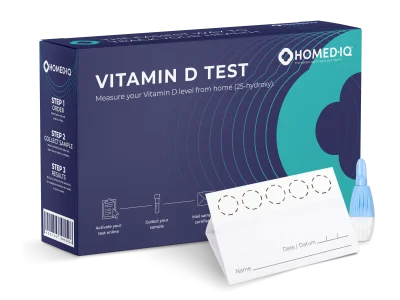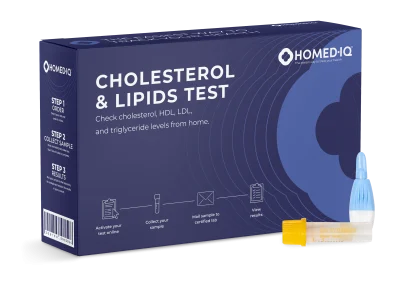C-reactive protein (CRP) is a protein that is produced by the liver. Your liver releases more CRP into the bloodstream when there is inflammation in your body. Inflammation is part of your body’s immune response to protect your tissues and help them heal (MedlinePlus). Inflammation can occur due to an infection, illness, autoimmune condition, or after tissue damage. High CRP can be a sign of a health condition that causes inflammation. A CRP test is often used to check for and monitor inflammation from acute or chronic illnesses.
A highly sensitive CRP (hs-CRP) test is more sensitive than a regular CRP test and can detect smaller increases in CRP. Elevated hs-CRP has been linked to an increased risk of heart attack, stroke, and heart disease (The Emerging Risk Factors Collaboration, 2010). Additionally, people who have had one heart attack are more likely to have another if they have a high hs-CRP level (Mayo Clinic, 2022). Therefore, hs-CRP tests are used as a predictor of cardiovascular risk (Harvard Health, 2017), along with other predictors like LDL and triglycerides.
What is CRP?
CRP is a protein released by the liver in response to inflammation (MedlinePlus). A wide variety of conditions can cause an increase in CRP, including infections, injuries, and other diseases. Lower levels of inflammation as measured by a hs-CRP test can indicate that there is inflammation in the arteries of the heart, which can increase the risk of heart attack or stroke (Mayo Clinic, 2022). CRP and hs-CRP can be measured using a blood test. These tests cannot determine the cause of the inflammation, or where it is coming from. This means elevated hs-CRP can occur without affecting the heart.
Why is CRP important?
CRP is often measured to help find or monitor inflammation in the body. This inflammation may be caused by infections, injuries, or chronic diseases. hs-CRP can help assess the risk of stroke, heart disease, or a first and second heart attack (Harvard Health, 2017).
What are normal CRP values?
A normal CRP value in an adult with no other inflammatory conditions is less than 3 mg/l. If CRP is above 3 mg/L, there is an increased risk of cardiovascular disease. However, it is possible that high CRP is not related to your heart at all. This is why the test result should be interpreted in relation to other risk factors, like obesity, cholesterol levels, and cigarette use. Very high levels of CRP may be due to inflammation in the body that requires medical attention, such as an infection.
Interpretation of hs-CRP values
< 1mg/l: low risk
1 to 3 mg/l: moderate risk
>3 mg/l: high risk
> 10 mg/l: infection or inflammation
Source: Mount Sinai
Can CRP be too high or too low?
There is no CRP level that is considered too low. As mentioned above, a CRP level above 3 mg/L is considered high risk for heart disease (Nehring, 2022).
Related Markers
Lower vitamin D levels have been found to be associated with elevated CRP (Zhou & Hyppönen, 2022). With the vitamin D test from Homed-IQ you can test whether you have a deficiency of this vitamin from the comfort of your own home. Furthermore, high CRP is not always associated with heart problems and should be assessed alongside other measurements of cardiovascular risk, like LDL cholesterol (Ridker, 2002).
-

Vitamin D Test
€45,00 -

Cholesterol & Lipids Test
€39,00
Causes of high CRP
High CRP may be caused by an infection, injury, or chronic diseases like rheumatoid arthritis. Elevated hs-CRP can be caused by lifestyle factors such as aging, smoking, obesity, diabetes, pregnancy, or insomnia (Cleveland Clinic, 2022). During atherosclerosis, or a thickening of the arteries with plaque, hs-CRP can also be elevated. This is due to inflammation in the blood vessels that carry oxygen and nutrients from the heart to the arteries (Johns Hopkins), and is why CRP is associated with cardiovascular disease. .
The consequences of high hs-CRP
High hs-CRP is associated with an increased risk of cardiovascular events, such as heart attacks (Harvard Health, 2017). This is why it is increasingly used as a predictor for future cardiac events, often along with other predictors for heart health such as blood pressure, smoking status, and cholesterol.
What can I do if my CRP level is too high?
If the result of your CRP test is elevated, it is important to speak to your doctor. If high CRP is caused by a medical condition, your doctor will identify the cause and begin treatment if needed. If hs-CRP is elevated, the doctor can assess cardiovascular risk with additional testing and prescribe medications such as statins if needed. Additionally, you can incorporate lifestyle changes to help reduce hs-CRP and stay heart healthy. These changes include:
- Quit smoking
- Maintain a healthy weight
- Eat anti-inflammatory foods, such as whole grains, fruits, vegetables, nuts, beans, and fatty fish
- Be more active
Source: Johns Hopkins
References
Assessing Cardiovascular Risk with C-Reactive Protein. (2021, August 8). Johns Hopkins Medicine. https://www.hopkinsmedicine.org/health/treatment-tests-and-therapies/assessing-cardiovascular-risk-with-c-reactive-protein
C-reactive protein. (n.d.). Mount Sinai Health System. https://www.mountsinai.org/health-library/tests/c-reactive-protein
C-reactive protein concentration and risk of coronary heart disease, stroke, and mortality: an individual participant meta-analysis. (2010). The Lancet, 375(9709), 132–140. https://doi.org/10.1016/s0140-6736(09)61717-7
C-Reactive Protein (CRP) Test. (n.d.). https://medlineplus.gov/lab-tests/c-reactive-protein-crp-test/
C-Reactive Protein (CRP) Test: What It Is, Purpose & Results. (n.d.). Cleveland Clinic. https://my.clevelandclinic.org/health/diagnostics/23056-c-reactive-protein-crp-test
C-reactive protein test – Mayo Clinic. (2022, December 22). https://www.mayoclinic.org/tests-procedures/c-reactive-protein-test/about/pac-20385228
Harvard Health. (2017, March 21). C-Reactive Protein test to screen for heart disease: Why do we need another test? https://www.health.harvard.edu/heart-health/c-reactive-protein-test-to-screen-for-heart-disease
Nehring SM, Goyal A, Patel BC. C Reactive Protein. [Updated 2022 Jul 18]. In: StatPearls [Internet]. Treasure Island (FL): StatPearls Publishing; 2022 Jan-. Available from: https://www.ncbi.nlm.nih.gov/books/NBK441843/
Ridker, P. M., Rifai, N., Rose, L., Buring, J. E., & Cook, N. R. (2002). Comparison of C-Reactive Protein and Low-Density Lipoprotein Cholesterol Levels in the Prediction of First Cardiovascular Events. New England Journal of Medicine, 347(20), 1557–1565. https://doi.org/10.1056/nejmoa021993
Zhou, A., & Hyppönen, E. (2022). Vitamin D deficiency and C-reactive protein: a bidirectional Mendelian randomization study. International Journal of Epidemiology. https://doi.org/10.1093/ije/dyac087






